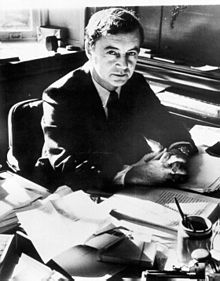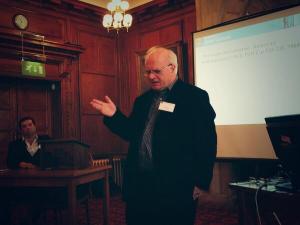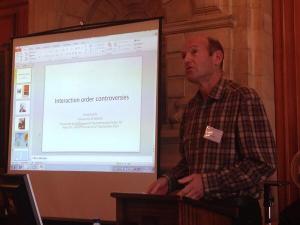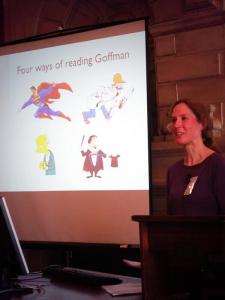“I have no universal cure for the ills of Sociology. A multitude of myopias limit the glimpse we get of our subject matter” (Erving Goffman, 1983: 2)
On September 27th, a conference was held at the University of Cardiff where participants discussed the influence of Goffman’s concept of the “interaction order” on sociology and related disciplines. Four speakers, Paul Atkinson, Greg Smith, Randall Collins, and Susie Scott explicated the origin, application and further development of Goffman’s concepts and analytic devices.
Atkinson delivered a performance that would better be shown as a video-clip than summarised in a written paragraph. He began by highlighting that Goffman’s interest was interaction as it happens and he demanded from his students to “go out and uncover something”, rather than to concern themselves with theory and concepts. By drawing on short video-clips from masterclasses for a tenor Atkinson illustrated some of the aspect of the “interaction order” and highlighted that for Goffman it was important to unpack the intrinsic properties of situations without attributing them to individual participants. This of course is not unproblematic as situations are loaded with a history that can hardly be understood from the situation at hand alone. The sociologist therefore needs to embed themselves within situations, make observations and conduct interviews to be able to understand the events. Thus, they will be able to make sense of how the participants refer to and draw on the history of the situation to go about the action at hand.
Smith illustrated his talk “Interaction Order Controversies” with photographs he had taken on the Shetland Islands where Goffman had gathered the data that form the basis for his PhD and for what we know today as “The Presentation of Self in Everyday Life.” It is the original PhD thesis where Goffman uses the term “interaction order” for the first time. Then however it took until 1982/3 before he again uses the term to highlight the myopia of contemporary sociology. In the time he deployed concepts like “copresence” and “small behaviours” to denote the organisation of conduct in situations. Aside from exploring the origin and use of “interaction order” and related concept in Goffman’s writings Smith also discussed how the concepts sits within the micro-/macro debate that has been ongoing since sociology was founded as a discipline. Aside from talking about Goffman’s work, Smith also talked about Goffman as an academic who at his time was one of the best paid sociologists in the USA; he obviously was very much aware of his value and was able to use it to advance his career.
This leads us to Randall Collins’ talk who drew relations between Goffman and Garfinkel as well as to other areas of sociology that often are described as macro-sociology; Giddens to mention but one representative, used Goffman and Garfinkel to underpin his structuration theory. In his talk Collins drew attention to some curious aspects of Goffman’s work, such as his heavy reliance on codes of conduct as resources for his studies whilst at the same time in the 1960s young people were distancing themselves from just that order and the related rituals described in these books. He pointed out however the richness of Goffman’s work and how he addressed the micro-/macro-question by explicating the ingredients of interaction rituals and their link to social structure; for instance, he showed that different people deploy different greeting rituals, wear different clothes etc. displaying their ‘place’ in society. Collins, of course, is very well known for his studies of violence and conflict. In his talk he showed how that research links in to Goffman’s studies of interaction rituals in that people when being violent manage the impression they give of themselves.
The final talk was delivered by Susie Scott whose interest in Goffman is known for example through her work on Total Institutions and Shyness. In her talk she elaborated on four facets she sees in Goffman: the hero, the detective, the villain and the magician. She brought these four images of Goffman to life by referring to her research on shyness, intimate deception, and others. At various points her talk showed close relationships to the points raised by the talks by Atkinson, Smith and Collins. In particular her reference to Goffman the villain linked nicely into Smith talk that touched on the sometimes not easy character of Goffman and his very well known ‘unusual’ behaviour at social gatherings.
The presentations together with the discussions during sessions and in breaks showed how relevant and influential Goffman still is for sociology. As time goes by his influence is growing beyond sociology and reaches into performance studies, management and marketing as well as into various areas engineering including the design of virtual worlds and social networking sites.
The conference was organised by Martin Innes and William Housley. A Twitter stream accompanied the event managed by Robin Smith. With the #socsigoffman you can trace some of the information of the event.
Victoria Silverwood (@silverwoodVS) storified the event.
This photographs in the above have been lifted from the @CardiffSocSi
Recent Articles in Symbolic Interaction related to Goffman
Phil Strong: The Importance of Being Erving
Susie Scott et al. Goffman in the Gallery: Interactive Art and Visitor Shyness
Chris Conner’s Review of Stigma Revisited
@dirkvl





